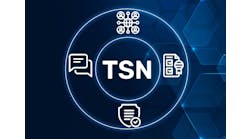Time-sensitive networking (TSN) is the most recent leg of the journey that will make critical data available where and, most importantly, when it’s needed. The automotive industry’s use of audio video bridging has evolved into time-sensitive networking for in-vehicle and out-of-vehicle communications.
But what exactly is TSN, and why does it matter?
“On the one hand, time-sensitive networking denotes a set of IEEE 802 standards, which extends the functionality of Ethernet networks to support a deterministic and high-availability communication on Layer 2,” explains Dipl. Ing. André Hennecke, researcher at DFKI, a research center in Kaiserslautern, Germany. “In particular, this includes an improved timing synchronization and a real-time scheduling method, enhancements of the stream reservation protocol, explicit path control and network policing procedures.”
On the other hand, the term “time-sensitive network” is also used to designate a series of acts from different organizations to enable a deterministic communication via Ethernet, not only with a focus on Layer 2, but also with a view on Layer 3 (DetNet), applications and certification processes, such as those from AVnu Alliance, says Hennecke.
“It’s possible to have a network that offers no value to a customer, even though it conveys 100% of the requested information, simply because of the transmission latency it introduces,” warns Doug Taylor, principal engineer, Concept Systems, a system integrator in Albany, Oregon. The aim of TSN is to eliminate that latency for critical data by reserving a traffic lane for those packets.
At one level, time sensitive networking it is a set of IEEE 802.1 and 802.3 standards, explains Paul Didier, solutions architect manager at Cisco. “The objective is to enhance Ethernet and core standard networking to better support time-sensitive applications, such as industrial automation control,” he says.
“We’re trying to match up standard networking with a lot of the requirements coming out of industrial automation and control. The concept of these control transactions or messages is a little challenging. Control engineers think they’ve got a controller or motor, and there’s a wire between the two of them. Technically, they understand that moving to standard networks and being able to do things in those models makes things a lot easier. Queuing the stuff up is counter-intuitive. They’re looking for deterministic network performance characteristics around latency, jitter and reliability that are easy to implement and use. It gives them an open and interconnected network that allows much more freely flowing information from those devices and to enhance and add to those devices over time, which drives the overall story of the IoT, where you can do off-line or close-to-the-machine. You need access to the data without having to drop extra lines in. It’s about convergence. There’s all of this IIoT, and it’s all about these things using the Internet. Aren’t there different requirements? Isn’t there a reason they haven’t used the Internet? Should we make some modifications?”
Also read: Why deterministic Ethernet matters to manufacturing
At the heart of TSN are mechanisms that provide time synchronization for networked devices and scheduled forwarding of defined traffic flows through the network, explains Markus Plankensteiner, vice president, sales industrial, North America, and global alliance manager, TTTech Computertechnik (www.tttech.com). “Through time synchronization and scheduling, TSN delivers deterministic communication over standard Ethernet, thereby enabling the convergence of critical control traffic with data traffic over one infrastructure without the need for gateways or proprietary solutions,” he says.
“The TSN standards define mechanisms for the time-sensitive transmission of data over Ethernet networks; these in particular address the transmission of data at very low latency and high availability, allowing for time-determination communication and synchronization,” says Sari Germanos, open automation business development manager, B&R Industrial Automation.
Time-sensitive networking is a collection of projects aimed at improving Ethernet, and specifically Internet technologies for time synchronization, explains Joey Stubbs, P.E., North American representative, EtherCAT Technology Group. “These projects are intended to improve routing, pre-emption, time synchronization, security and throughput of Ethernet traffic for A/V streaming and bridging,” he says. The IEEE 802.1 standard encompasses the work of the TSN Task Group, which used to be called the AVB Task Group for audio video bridging.
Fieldbuses are proprietary, well-designed for the applications they support, but getting data out of them is a bear, says Didier. “We can support that much better than the much-less-deterministic methods that we currently have,” he explains. “They have control problems they’re trying to solve. We’ve got an ecosystem we’re trying to build this into. This isn’t going to be a separate network configuration. It’s simply incorporated in the standard tools that you use. The idea is those programs understand the control loops and what information needs to come in and leave. The network will say it can handle it, sometimes with modifications, and push it out into the network. That’s the architecture we’re putting together on top of the IEEE standards.”
Time sensitive networking, as a concept, is analogous to real-time networking, where real time is the amount of time that network data is accurate and consistent enough for the control system to make reliable decisions, explains Phil Marshall, CEO of Hilscher North America. “In some applications, this requirement is measured in milliseconds, in others, in microseconds,” he says.
The standardization of time-sensitive features within IEEE 802.1/802.3 to be rolled out in a large number of consumer and industrial chipsets will mean that many more people will be able to gain access into the development of industrial applications, explains Dr. Michael Hoffmeister, portfolio manager, software, at Festo. “This is expected to stimulate a diversity of new use cases, applications and software tools and will therefore trigger also new impulses on the shop-floor level,” he predicts. “Moreover, TSN allows for real-time communication in parallel to standard Ethernet-based office communication over the same network infrastructure, which increases flexibility in the network architecture.”
Time sensitive networking is the capability to do true real-time traffic with known worst-case end-to-end transmission times, says Mark Hermeling, director, product management, VxWorks, Wind River. “Ethernet as we know it today is best effort, at best,” he cautions. “There is no way to calculate the time it will take for a packet to go from A to B. There is a lot of variability in the transmission times that can be caused at multiple levels in the OSI model.”
There are fieldbus protocols, such as EtherCAT and Profinet, that have sprung up over the years to remedy this, continues Hermeling. “Many networks have one connection for real-time traffic to real-time devices and one connection for general-purpose traffic such as connecting to IT networks,” he explains. “Time-sensitive networking promises to provide known transmission times for real-time packets, while allowing general-purpose traffic to be intermixed on the same connection.”
Time-sensitive networks have very little latency, explains Sloan Zupan, senior product manager, Mitsubishi Electric Automation. “In machine control, it’s critical that automation components communicate with one another using a deterministic network,” he says. “Protocols that use standard TCP/IP Ethernet introduce latency because it is a nondeterministic protocol.”
In the generic sense, TSN is a set of capabilities being added to standard Ethernet to support applications that need deterministic characteristics for data transfer, explains Todd Walter, chief marketing manager, National Instruments and industrial segment chair of AVnu Alliance. “If you want to do a control loop, that is very difficult today,” he says.
“You can engineer and constrain what traffic goes on the network. The level of performance isn’t as high as you could get. Time sensitive-networking actually will schedule a class of traffic through the network. An analogy is, if you have an express lane on a highway, cars in that lane can get higher priority. If you still have a bunch of cars at the same time, you can still have congestion. You can control and time when cars go in and when the lights change, so you can get deterministic transfer. That’s what’s being added.”
For once, the industry has a term that means exactly what it sounds like, says Dr. Richard Soley, executive director of the Industrial Internet Consortium (IIC). “It’s connecting devices for which the connectivity is time-sensitive—that is, communications must be received with minimum latency and/or maximum throughput,” he explains. “The common technical term is hard real-time, meaning that there is an absolute deadline, after which the system fails—the worst-case execution time can be characterized precisely; or there’s soft real-time, meaning the system may fail gracefully after the deadline.”
Rockwell Automation follows the IEEE definition of time sensitive networking. “It’s a bundle of extensions primarily to the 802.1 spec, with some also impacting 802.3 capabilities such as scheduling,” says Paul Brooks, business development manager. “We very much see it as being a bundle of separate things.”






